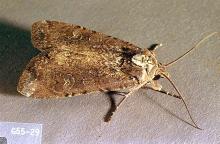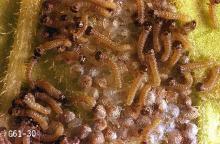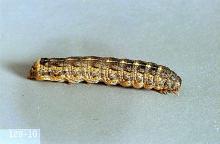Bertha armyworm (Mamestra configurata)
Mint cutworm (Heliothis phloxiphaga)
Spotted cutworm (Xestia c-nigrum)
Variegated cutworm (Peridroma saucia)
See also:
Pest description and crop damage Variegated cutworm larvae are brown to tan usually with a series of white or yellowish "keyhole" marks on each dorsal (top) abdominal segment, though may not always be visible on all segments. Bertha armyworm larvae are highly variable, from uniform pale green to black with fine longitudinal yellow lines.
Mint cutworms are large, 1.5 to 2 inches in length, yellow, tan, or green larvae with black spots over the body, similar to corn earworm. Damage is similar to that of the variegated cutworm and alfalfa looper, but this insect seldom is a problem of economic importance on mint. Spotted cutworm larvae vary in color, but most are dark brown to black, with distinct, triangular markings on the back.
Scouting and thresholds Scout for larvae beginning in late June to determine the need for insecticide application to prevent oil yield loss. Inspect surface of the soil under the mint canopy after shaking stems to dislodge larvae. Do this in a number of sites throughout the field. Carefully look for larvae in soil cracks, under leaves, and in old, brown, curled leaves. Record the number of larvae per sq ft. Treatment levels can vary from one to four larvae per sq ft depending on time to harvest, biological controls observed, and price of oil. Chemical treatments are most effective when larvae are from 2nd to 4th instar.
Management-biological control
Bacillus thuringiensis formulations have not been effective on these pests infesting peppermint. Neither do insect viruses, important natural controls of loopers, help in reducing these pests
Management-chemical control
Warning: Do not apply if bees are working in blooming mint.
- acephate (Acephate 90 WDG, Orthene 97, Bracket 97 WDG, Livid 90 Prill) at 1 lb ai/A. PHI 14 days. REI 24 hr. Retreatment interval 7 days. Do not exceed 2 lb ai/A per season, nor make more than two applications per crop season. The grazing of animals on treated areas, and the feeding of spent mint hay to animals are prohibited.
- azadirachtin (AzaMax) at 0.012 to 0.044 lb ai/Acre. PHI 0 days. REI 4 hr. Some formulations are OMRI-listed for organic use.
- Burkholderia spp. (Venerate XC) at 1 to 4 quarts/A. PHI 0 days. REI 4 hr. Armyworms only. OMRI-listed for organic use.
- chlorantraniliprole (Coragen, Vantacor) at 0.045 to 0.098 lb ai/A. PHI 3 days. REI 4 hr. Retreatment interval 14 days. Do not exceed 0.2 lb ai/A or 4 applications per calendar year. Vantacor label WA (Exp. 7-15-25) only. May be applied by chemigation.
- chlorantraniliprole/thiamethoxam (Voliam Flexi) at 0.1 to 0.125 lb ai/A. PHI 7 days. REI 12 hr. Retreatment interval 14 days. Do not exceed 15 oz/A Voliam Flexi or 0.188 lb ai/A of thiamethoxam or 0.2 lb ai/A of chlorantraniliprole per season. Apply in at least 10 gal water/A (ground) or 5 gal water/A (aerial). Do not use an adjuvant. Cutworms only.
- Chromobacterium subtsugae (Grandevo) at 0.3 to 0.9 lb ai/A. PHI 0 days. REI 4 hr. May be applied by chemigation. Apply in at least 10 gal water/A. Armyworms only. OMRI-listed for organic use.
- indoxacarb (Avaunt) at 0.065 lb ai/A. PHI 7 days. REI 12 hr. Retreatment interval 3 days. Do not exceed 0.26 lb ai/A per season or make more than 4 applications per year. May be applied by chemigation. Apply in at least 20 gal water/A.
- methomyl (Lannate SP) at 0.9 lb ai/A. PHI 14 days. REI 48 hr. Do not apply more than 1.8 lb ai/A per growing season or 4 applications. Most effective on larvae smaller than 0.5 inch. Restricted use.
- methoxyfenozide (Intrepid 2F) at 0.16 to 0.25 lb ai/A. PHI 14 days. REI 4 hr. Do not apply more than 1.0 lb ai/A per year. Time applications to small larvae (2nd instar) and egg masses.
- spinetoram (Radiant SC) at 0.031 to 0.094 lb ai/A. PHI 7 days. REI 4 hr. Retreatment interval 4 days. Do not apply more than 0.305 lb ai/A per crop or make more than 4 applications per year. Target eggs and small larvae. Do not make more than 2 successive applications of this or other group 5 insecticides (spinetoram and spinosad).
- spinosad (Success, Entrust SC) at 0.062 to 0.156 lb ai/A. PHI 7 days. REI 4 hr. Retreatment interval 4 days. Do not exceed 0.45 lb ai/A per crop year, make more than four applications per calendar year or more than three applications per crop. Target eggs and small larvae. Do not make more than 2 successive applications of this or other group 5 insecticides (spinetoram and spinosad). Entrust SC is OMRI-listed for organic use.
- tebufenozide (Confirm 2F) at 0.09 to 0.12 lb ai/A early season and 0.12 to 0.25 lb ai/A mid to late season. PHI 14 days. REI 4 hr. Retreatment interval 10 days. Do not exceed 1 lb ai/A per season. Apply in at least 8 gal water/A to small plants and 10 gal water/A to dense stands. Addition of a spreader-binder is recommended.







